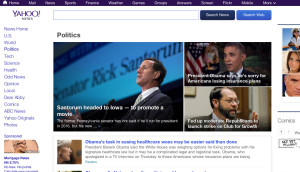
Reporters for the student-run Daily Cardinal newspaper at the University of Wisconsin-Madison are posting stories during peak traffic hours for the web. Their counterparts at UCLA’s Daily Bruin, meanwhile, are pushing hard into mobile news.
And this fall marked historic shifts for at least two state university newspapers–Virginia’s The Cavalier Daily and Missouri’s The Maneater–which reduced their printing schedules in favor of more real-time publishing.
Virginia’s student paper went from printing daily to twice a week, while Missouri’s Maneater switched from printing twice to once a week.
“In today’s age, with the immediacy of web and mobile, we were caught in this catch-22,” said Ted Noelker, editor-in-chief of The Maneater. “We were a biweekly, so we were still trying to be timely, but there was no way we were ever going to catch up with the up-to-the-minute news that can be delivered on web and mobile.”
Until recently, college papers seemed insulated from the massive losses in advertising and circulation that slammed American newspapers, thanks largely to their built-in hyperlocal audiences and the fact that advertisers covet the youth demographic.
But that is changing as more students get their news online and fewer grab the print product on their way to class, student editors and industry analysts say. In some cases, declines in circulation and advertising are putting financial pressures on student newspapers, especially those that rely on advertising to pay their staffs.
Like their metropolitan newspaper counterparts, student publications nationwide are trying to meet the digital challenge by revamping themselves to expand their audiences online and find new sources of revenue.
“There’s been a genuine push among student news teams to redesign and in a larger sense rebrand as being a little bit hipper, a little bit more student reader friendly,” said Dan Reimold, who covers the student press via his blog, College Media Matters. “There’s been both a digital and a mobile push in that direction.”
A few examples of what college papers are experimenting with as they hit the reset button:
- The University Daily Kansan of the University of Kansas now staffs a five-person web desk, including two devoted to social media management.
- The Daily O’Collegian is considering using paid tweets, which is advertising via the paper’s Twitter handle, @OColly.
- CM Life of Central Michigan University has started using an app called Aurasma, which allows users to point their phones at photos in the print edition of the paper and watch them turn into related videos.
- The Michigan Daily of the University of Michigan and the Emerald have both produced commemorative books memorializing their football teams. (You can find them here and here.)
The University of Georgia’s student newspaper, The Red and Black, was one of the first student newspapers to change to a web-first approach in 2011, according to PBS MediaShift. It was closely followed by the Emerald, of the University of Oregon, which started planning to overhaul its model in early 2012 and has since expanded to include extra elements such as a housing marketplace, a separate humor website known as Quackd and a space called the Garage, where a developer brainstorms creative ways to present the news.
College newspaper editors from across the country are following suit.
Trevor Graff, editor-in-chief of The University Daily Kansan, said he recognizes that building a digital product will improve not only readership but also advertising.
“We sat down and looked at what we had, and there was great design, but the content was behind [on the website],” Graff said. “Getting that multimedia packaging working is essential to even being able to sell digital sales.”
In addition to expanding its digital desk, he said The University Daily Kansan is also publishing online exclusives for the first time in several years. This produced 50,000 visits in the month of September and 40,000 unique visitors. In a two-week time period, the number of site visits rose from 16,000 to 17,300, he said.
He said the paper, like many others, is still trying to figure out how to engage readers online.
“We’re positioned in a way that if you’re on campus, you’re going to run into a Kansan rack and be able to pick up the paper, whereas you might not necessarily go straight to our website for some of these stories,” Graff said. “That’s the challenge you deal with — you have to create a product that engages your readers in a way that makes them want to come to you first.”
Student editors said they are also turning their focus to social media.
Abigail Becker, editor-in-chief of the University of Wisconsin-Madison’s Daily Cardinal — one of two student newspapers there — said a greater presence on social media has been key, for both recruiting staff members and building a following online. The publication has been more active on Facebook and Twitter in addition to its creation of an Instagram account.
The efforts have paid off: The Daily Cardinal now has 5,483 followers on Twitter.
Yet she stresses that the publication still values its status as a daily paper.
“Students still want to do the crossword in class or if there’s a profile of their friend, have that actual copy,” she said.
Other newspapers editors, such as those at The Maneater, said they believe that transitioning away from a daily format is essential in order to focus their resources.
Noelker said the paper now focuses more on features while the website is devoted to hard news. Benefits of the shift include more time to produce well-rounded pieces and work on The Maneater’s mobile app, which is still in development.
However, the paper — and many of those already mentioned — still relies primarily on print advertising to fund the product, according to student editors.
The Daily Bruin of UCLA also still makes much of its money through print ad sales but has put a much greater emphasis on mobile, its staff says.
“It’s always been a big goal to go toward more web first; that’s been the buzzword of the past few years, but the motivation for that has been our dropping print circulation,” said Jillian Beck, editor-in-chief of the Daily Bruin. “We had to rethink where our audience was, and right now, our audience is mostly mobile.”
This realization was the stimulus for the 111 apps the UCLA Student Media department has created over the past year. These are not necessarily newspaper-related; they range from SafeSex 101, which gives students tips for safe sex and provides a list of helpful resources to learn more, to UCLA Study Abroad, which allows students to search for study abroad programs and scholarships in the area.
Director Arvli Ward brings in up to 100 students at a time who learn about the concepts necessary to build an app and then literally do so.
“It’s pretty simple conceptually,” he said. “It’s really about one thing: How can we force student energy into a context that allows them to exercise their entrepreneurial and social impulses to produce apps at a very high level?”
Ward said these apps have generated about $35,000, which is only about 2 to 3 percent of the department’s total revenue. He’s optimistic, though — no other university is doing as much in the mobile sphere, he said. (Reimold agreed.)
The question remains as to why college newspapers have mostly resisted web innovation until now.
Graff, of The University Daily Kansan, said it’s been difficult for his staff to move away from what they’ve been doing well for decades.
“This isn’t just a procedural, structural change; shockingly enough for us, it’s been a cultural change, too,” he said. “There’s actually been a little bit of a push back. People are asking, ‘Why focus on the web when we put the paper in front of 11,000 kids every day?’”
Sally Asher, editor-in-chief of The Daily O’Collegian at Oklahoma State University, agreed, adding that advertisers are also wary of moving toward the web.
“In small-town Oklahoma, people are like, ‘Wait, what’s the Internet?’” she said. “People are really hesitant to read online, and because we’ve had such low page views on the website in the past couple of years, people are like, ‘Well, people aren’t looking at your page so why should I advertise with you online?’”
The Daily O’Collegian has made an effort to find other sources of revenue; the paper implemented a paywall in 2011 that charges $10 a year to access the site — but only for readers more than 25 miles away from campus who visit the site more than three times a month. Asher said the paper had 133 subscribers as of August, but she would prefer not to charge for content if she had more say.
Other student editors said they also recognize that a print-centric model can only subsist for so long, so they’ve started to experiment to see what might work better in the digital age.
Sam Stites, editor-in-chief of the Emerald, said this trial and error is crucial in an age of entrepreneurship and media revolution.
“A lot of these traditional newspapers are afraid to change because if they fail, that’s the end game for them, but with us, we have a lot of room to fail and try again,” he said. “A motto here at the University of Oregon School of Journalism is, ‘Fail harder’ — because you don’t learn unless you’re failing and failing hard.”
Reimold said he’s encouraged by the number of student press outlets who are “throwing things against the wall and seeing what sticks.”
“The student press outlets whose staff I see are happiest and most excited about doing their journalism work every day are the ones who decided to blow it up, to leap off the cliffs and see where they land, to truly try and change as much as possible simply for the sake of changing and also for just seeing if they can maybe lead the way and not follow,” Reimold said.
Editor’s note: This story has been updated to reflect the increased number of apps created at UCLA and the number of Twitter followers at The Daily Cardinal since the story was originally written.








Leave a Comment